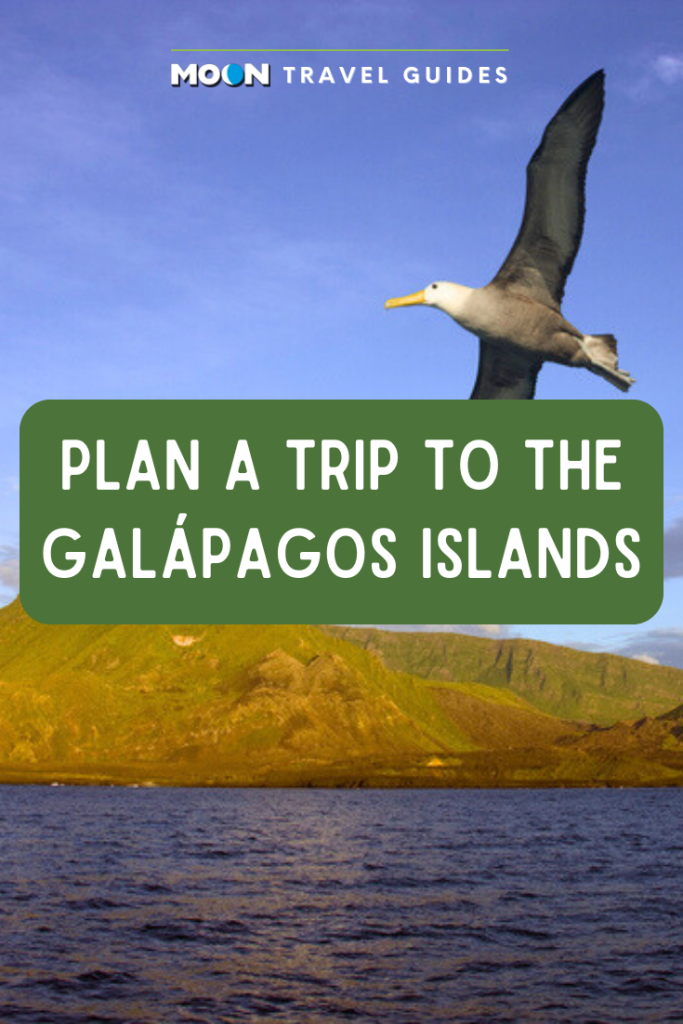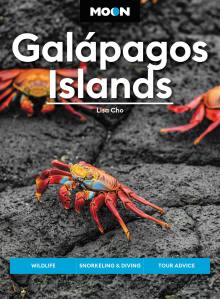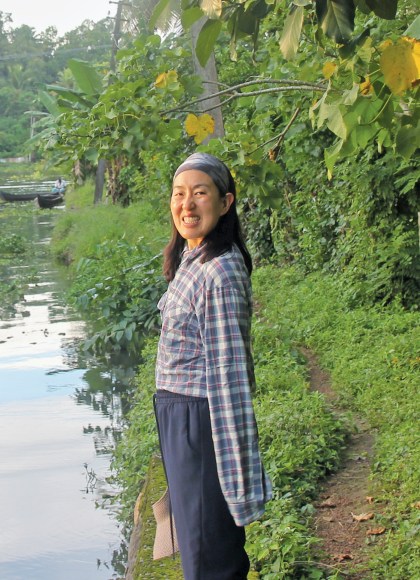Planning a Trip to the Galápagos Islands
Visiting the Galápagos Islands is the experience of a lifetime, but it does take a little research (and effort!) to get the details in order. Here’s what you need to know to get started.
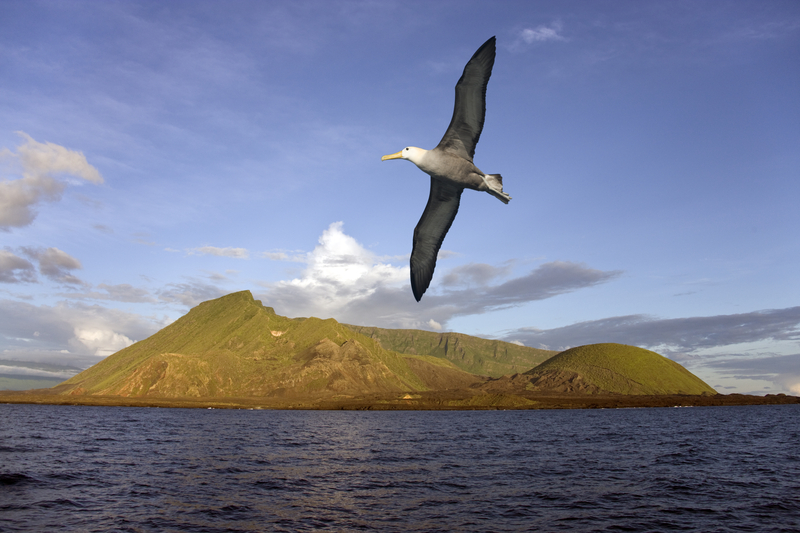
Where to Go
Santa Cruz and Nearby Islands
The archipelago’s tourism hub is centered around the busy but pleasant Puerto Ayora. Highlights include the Charles Darwin Research Station and Tortuga Bay, one of the islands’ most beautiful beaches. Lava tunnels, craters, and giant tortoises await in the highlands, while surrounding islands provide excellent excursions, notably the land iguanas on Plaza Sur and Santa Fé, and frigates and blue-footed boobies on Seymour Norte, schooling hammerheads at Gordon Rocks, and the iconic pinnacle of Bartolomé.
San Cristóbal
Sea lions dominate the waterfront of Puerto Baquerizo Moreno, and you can spot the colonies right in town, and hike to nearby beaches and snorkeling spots La Lobería, Punta Carola, Darwin Bay, and Playa Baquerizo. Offshore, the trips to Isla Lobos and Kicker Rock offer incredible snorkeling with sea lions and sharks. At the far eastern side of the island is Punta Pitt, one of the few spots where all three booby species are seen together. It’s also the departure point for day tours to Española, one of the top sights in the archipelago.
Isabela
Isabela is the giant of the archipelago, occupying half the total landmass. It also boasts the most dramatic landscapes, with six active volcanoes. The highlight is the Sierra Negra hike, which circles the second-largest crater in the world before descending to the spectacular landscape of Volcán Chico. There are excellent boat trips to Los Túneles in the south and Las Tintoreras near town. For cruises, the western side of the island offers beautiful hiking at Darwin Lake, snorkeling with sea turtles and flightless cormorants at Punta Vicente Roca, and keeping an eye out for whales while cruising in the channel.
Floreana
Floreana’s lush, peaceful ambience belies its troubled history, which has kept amateur sleuths guessing for decades. Highlights include a quirky post office and snorkeling at Post Office Bay and Mirador de la Baronesa. Offshore, cruises can access excellent snorkeling at Devil’s Crown and Champion Island.
Remote Uninhabited Islands
The blackened lava trails of Santiago recall a land that time forgot. Explore this unworldly landscape in the trails around Sullivan Bay. The nearby islet of Bartolomé—a partially eroded lava formation flanked by two beaches with the black lava trails of Santiago in the distance—is the most-photographed sight in the Galápagos.
Fernandina is one of the least-visited islands, and Punta Espinosa, the sole visitor site, has the largest colony of marine iguanas in the archipelago and the biggest nesting site for flightless cormorants.
Española is the world’s biggest breeding site for waved albatross.
Fewer boats make it to the far north, but Genovesa is enduringly popular for its large red-footed booby populations. Wolf and Darwin Islands are the preserve of experienced divers, who can enjoy the awe-inspiring sight of whale sharks June-November.
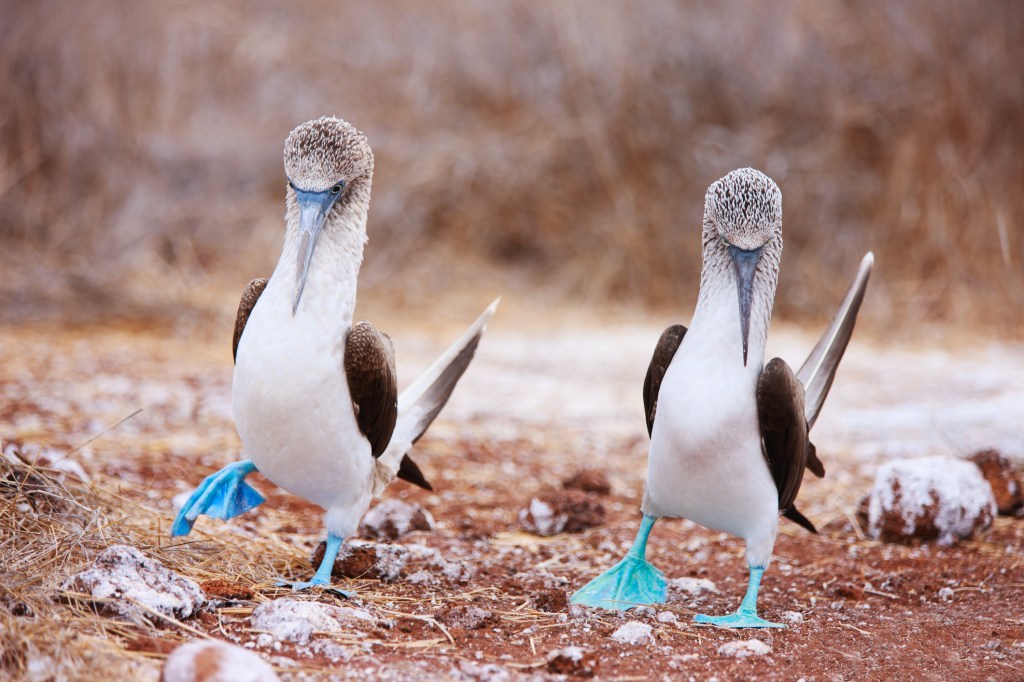
Know Before You Go
When to Go
The Galápagos Islands are a year-round destination, and even naturalist guides differ in their opinions of the best time to visit. You can even target specific wildlife events. There are two distinct seasons in the Galápagos: rainy season and dry season, though the best time to visit largely comes down to personal preference.
Many travelers consider wildlife when choosing a time to visit the Galápagos. The famous waved albatross visits Española only April-November. The comical mating dance of blue-footed boobies takes place May-June. October-November is a great time to see playful sea lion pups. For divers aboard live-aboard cruises, June-November is the prime season due to the presence of enormous whale sharks.
December-April is the rainy, hot season. The weather is sunny and interspersed with periods of rain. The seas are the calmest and the water is at its warmest, and it’s pleasant to swim without a wetsuit. Rain leads to an explosion of greenery on the hillsides of some islands, though the highlands and arid coastal areas don’t change much. The lush green highlands of the islands stay green year-round, and the arid coastal landscapes dominated by lava rock, mangroves, and cacti don’t change much either. The downside is that mosquitoes and the sun are the most intense; you may constantly feel sticky from bug repellent, sunscreen, and the humidity. This season coincides with the busiest tourist period around Christmas and early January.
June-October is the cool, dry season. There are fewer mosquitoes, and the temperature on land is more comfortable for most people. However, the landscapes are more barren and the sea becomes considerably rougher, so seasickness is more of a problem. You’ll need to wear a wetsuit for swimming and snorkeling; the waters can be surprisingly cold. The biggest upside is that the Humboldt Current brings nutrient-rich water from the south; this means marine animals like sea lions, marine iguanas, and seabirds that feed on fish are all more active. June-August is another high season, with many travelers coming for summer vacations.
The islands have short low seasons in May and September. These are the best times to secure last-minute availability, although September is often used by cruise-boat owners as an opportunity to do annual maintenance work. However, cut-price deals can be found year-round if you look hard enough and are flexible.
Passports, Tourist Cards, and Visas
Travelers to Ecuador will need a passport that is valid for at least six months beyond the date of entry. It is easy for most people to visit Ecuador because you don’t need to apply for a visa in advance (unless you are from China or some countries in Africa). On entry to Ecuador, you will get a tourist visa stamp (also called a T-3) that is good for 90 days. You can apply for more time (up to 180 days) by filling out paperwork and applying for an extended tourist visa (12-IX). When entering Ecuador, travelers must also be able to show a return or onward travel ticket out of Ecuador as well as “proof of economic means” (a credit card is usually good enough); the latter requirement is rarely enforced.
To enter the Galápagos, you must obtain the mandatory $20 transit control card from your departure airport (either Quito or Guayaquil). This helps regulate the exact number of visitors. Upon arrival in the archipelago there is a mandatory $100 national park entrance fee, payable in cash. It’s a hefty fee, but it helps preserve the islands’ fragile ecosystem. If you have a student or cultural visa, you pay $25, while Ecuadorians pay just $6. Note that a recent crackdown on illegal immigration means that staying beyond 90 days will result in immediate deportation.
Vaccinations
The U.S. Centers for Disease Control and Prevention recommend that travelers have routine immunizations as well as hepatitis A and typhoid fever vaccinations. Rabies vaccinations are also recommended for those venturing into rural areas.
Booking a Tour
In simple terms, the farther you are from the Galápagos, the more you pay. Cruises, land tours, and diving tours can all be arranged in your home country or through a travel agency in Ecuador. Keep in mind that when booking a tour from abroad, deposits are often collected for cruises, and payment in full for day tours is more common.
Many travel agencies in Quito and Guayaquil advertise tours, so shopping around is the way to go. Holding out for last-minute deals may save you anywhere from 5 to 35 percent, but be aware that it may leave you stranded as well. Some travelers with time on their hands even fly to the Galápagos, book into a cheap hotel for a few days, and take their chances on finding a last-minute cruise, saving 50 percent in some cases—but there are no guarantees.
The same applies to booking day tours and dive tours; the price for booking in advance are generally 20 percent or more than booking “last-minute” from the Galápagos, though you run the risk of popular tours selling out. It is generally easier to find last-minute deals if you are traveling solo or as a pair. The larger your group or family is, the harder to find availability on popular tours.
Transportation
Transportation to the islands is generally not included in the price of a tour. Flights to the Galápagos depart from Quito and Guayaquil daily. There are two entrance airports in the Galápagos: one on Baltra, just north of the central island of Santa Cruz, and one on San Cristóbal. The airport on Isabela is only used for interisland flights, and there are no airports on Floreana. Make sure you’re flying to the correct island to begin your tour. Prices are about $350 round-trip from Guayaquil and $400 from Quito.
If you are traveling to the islands without being booked on a tour, Puerto Ayora is the best place to arrange a budget tour. Note that getting from Baltra to Puerto Ayora is a journey in three stages involving two bus rides and a ferry ride. There are daily ferry shuttles from $30 per person one-way to the other three other ports—Baquerizo Moreno on San Cristóbal, Puerto Velasco Ibarra on Floreana, and Puerto Villamil on Isabela.
Ready to start planning the trip of a lifetime? The best way to do it is with a guidebook! Check out Moon Galápagos Islands for everything you need to know.
Related Travel Guide
Pin it for Later
